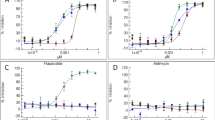Abstract
Cell suspensions of chili pepper (Capsicum annuum L.) were subjected to a selection process on semisolid medium containing the amino acid analog p-fluorophenylalanine (PFP). Four cell lines with different degrees of resistance were selected and suspension cultures were established from each of them. Resistance was retained even after 75 days of culture in the absence of PFP. PFP-resistant cell lines accumu lated higher levels of capsaicin than sensitive lines even after prolonged culture in PFP-free medium. Capsaicin production in non-selected cells was only 26.8% of that found in one cell line resistant to 500 μM PFP. The capsaicin content in the non-selected cell suspension and in one of the resis tant cell lines was 6.7% and 24.9% respectively, that of fruits.
Similar content being viewed by others
Abbreviations
- BA:
-
benzyladenine
- 2,4-D:
-
2,4-dichlorophenoxyacetic acid
- PFP:
-
p-fluorophenylalanine
- d. wt.:
-
dry weight
- f. wt.:
-
fresh weight
References
Ben-Hayyim G, Kochba J (1983) Plant Physiol 72: 685–690
Bennett D J, Kirby G W (1968) J Chem Soc (C): 442–446
Berlin J (1968) Z Pflanzenphysiol 97: 317–324
Berlin J, Vollmer B (1979) Z Naturforsch 34c: 770–775
Constabel F (1988) Biochem Cell Biol 66: 658–664
Flick CE, Jensen RA, Evans DA (1981) Z Pflanzenphysiol 103: 239–245
Gathercole RWE, Street HE (1976) New Phytol 77: 29–41
Gathercole RWE, Street HE (1978) Z Pflanzenphysiol 89: 283–287
Hall RD, Holden MA, Yeoman MM (1987) Plant Cell, Tissue and Organ Culture 8: 163–176
Iwai K, Suzuki T, Fujiwake H (1979) Agric Biol Chem 43: 2493–2498
Leete E, Louden MCL (1968) J Am Chem Soc 90: 6837–6841
Lindsey K (1985) Planta 165: 126–133
Lindsey K, Yeoman MM (1984a) Planta 162: 495–501
Lindsey K, Yeoman MM (1984b) J Exp Bot 160: 1684–1696
Lindsey K, Yeoman MM, Black GM, Mavituna F (1983) FEBS Lett 155: 143–149
Mavituna F, Wilkinson AK, Williams PD (1987) In: Verrall MS, Hudson MJ (eds) Separations for Biotechnology. Ellis Hordwood, Chichester. pp 333–340
Murashige T, Skoog F (1962) Physiol Plant 15: 473–497
Ochoa-Alejo N, García-Bautista (1989) Turrialba (In press)
Palmer JE, Widholm J (1975) Plant Physiol 56: 233–238
Quesnel AA, Ellis BE (1987) Plant Sci 49: 223–229
Salgado-Garciglia R, López-Gutiérrez F, Ochoa-Alejo N (1985) Plant Cell, Tissue and Organ Culture 5: 3–12
Smith PG, Villalon B, Villa PL (1987) HortScience 22: 11–13
Author information
Authors and Affiliations
Additional information
Communicated by J. M. Widholm
Rights and permissions
About this article
Cite this article
Salgado-Garciglia, R., Ochoa-Alejo, N. Increased capsaicin content in PFP-resistant cells of chili pepper (Capsicum annuum L.). Plant Cell Reports 8, 617–620 (1990). https://doi.org/10.1007/BF00270067
Received:
Revised:
Issue Date:
DOI: https://doi.org/10.1007/BF00270067



